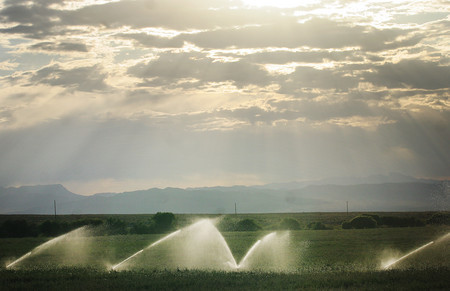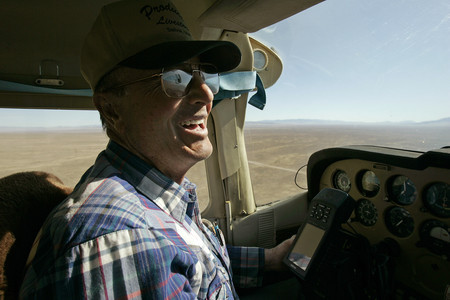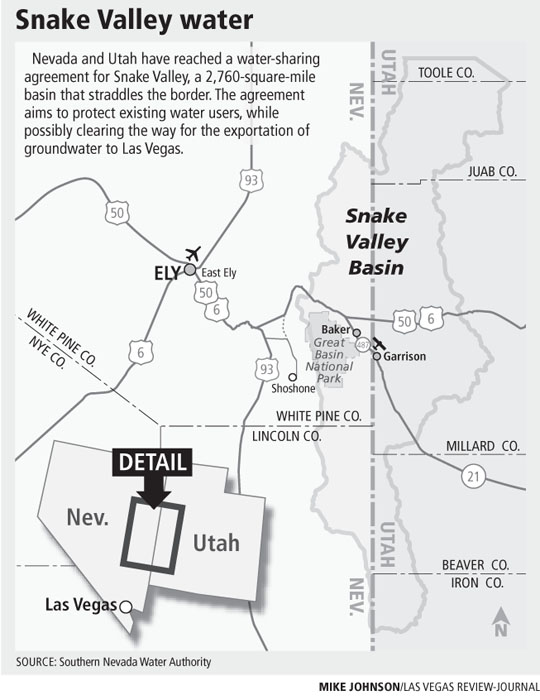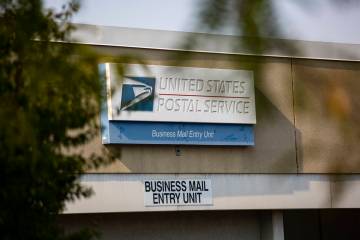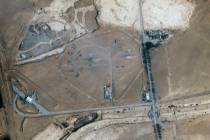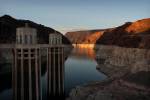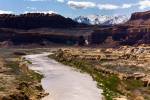States strike water deal
A potential water war between Nevada and Utah might end in a truce before a single shot is fired.
Water officials from the two states have reached an unprecedented agreement over a vast groundwater basin that is split by the border and targeted as a water source for thirsty Las Vegas.
The agreement divides groundwater in Snake Valley between the states and provides protections for farmers, ranchers and other residents.
It also could clear the way for the Southern Nevada Water Authority to tap the basin, though the agency will have to wait another decade for approval of its plans there.
As part of the pact, Nevada agreed to delay a hearing on the authority's water applications in Snake Valley until September 2019 to allow time for additional environmental studies.
"We think it's a fair and equitable agreement," said Allen Biaggi, who helped negotiate the pact as director of the Nevada Department of Conservation and Natural Resources. "It's intent is to preserve and protect the existing water rights in the valley."
Snake Valley covers an area larger than the state of Delaware but is home to just a few scattered towns and farms in a bleached sea of scrub brush.
Roughly two-thirds of the basin is in Utah, which is where most of the water use now occurs. Nearly all of the basin's recharge comes from the Nevada side of the line, where the north-south ridge of the Snake Range rises above 13,000 feet to comb rain and snow from the desert air.
The mountains are home to Great Basin National Park and Wheeler Peak, Nevada's second-tallest summit.
Though the water authority plans to take far more water from adjacent Spring Valley in Nevada, Snake has served as the focal point for opposition to the agency's proposed pipeline across eastern Nevada.
The project has long seemed destined to trigger a legal fight between Nevada and Utah, but Biaggi said the new agreement might keep them all out of the U.S. Supreme Court.
Under the deal's central provision, the two states agreed on how much groundwater the basin contains and how it should be divided: 132,000 acre-feet per year split right down the middle.
That estimate mirrors the findings of a three-year federal study of water supplies released in June 2007, though water officials from both states acknowledge more research is needed.
The 66,000 acre-feet set aside for each state under the deal includes current water allotments, an amount deemed available for future use and a block of water to be held in reserve pending further study.
In Nevada, 12,000 acre-feet in water rights already have been issued for Snake Valley. That leaves 36,000 acre-feet in available water and 18,000 acre-feet in reserve under the interstate deal.
On the Utah side of the line, 55,000 acre-feet has already been permitted for use, leaving 5,000 acre-feet available for development and 6,000 acre-feet in reserve.
About 326,000 gallons are in an acre-foot, which is enough water to supply two average Las Vegas homes for one year.
The agreement is the first of its kind between Nevada and Utah.
The Southern Nevada Water Authority is a party to the deal but receives no water as a direct result of it.
The agency's applications for groundwater in Snake Valley are still subject to a hearing and full review by Nevada's Division of Water Resources. The entire pipeline project will require federal approval at the end of an environmental review now under way.
The state hearing on the authority's Snake Valley applications was originally set for September of this year, but in April it was pushed back until 2011.
Water authority General Manager Pat Mulroy said putting it off for another 10 years will not jeopardize the larger project.
"That doesn't cause us any concern because that is the last valley on the system," she said.
Work on the proposed pipeline will start in the south and tap groundwater in Clark and Lincoln counties before reaching Spring Valley, on the east side of the Snake Range.
From there, plans call for the pipeline to branch into Snake Valley, Mulroy said, "but we would be well beyond 10 years before we do that."
The proposed network of pipes, pumps and reservoirs could stretch about 300 miles north from Las Vegas and cost between $2 billion and $3.5 billion, according to authority cost estimates now several years old.
Authority officials expect the pipeline to supply Las Vegas with 134,000 acre-feet of groundwater a year, enough for almost 270,000 homes.
Critics argue that the project will deliver far less water -- and cost billions of dollars more -- than officials say.
Critics also insist that large-scale groundwater pumping will devastate wildlife and the livelihoods of ranchers and farmers across eastern Nevada and western Utah.
The authority's groundwater applications in Snake Valley total more than 51,000 acre-feet.
Asked whether her agency hopes to win permission to pump all 36,000 acre-feet of water now deemed available there, Mulroy said, "Yes, absolutely."
It took four years to hammer out the agreement, which was prompted by a 2004 federal law requiring a deal between the two states before groundwater can be exported from any of the shared basins along the border.
Longtime Snake Valley rancher Dean Baker served on Utah's negotiating team for the final two years of the talks, an experience that seems to have left him frustrated and conflicted.
And why not? Baker is quite literally the man in the middle.
His home is on the Nevada side of the line, but much of his 12,000-acre ranch is in Utah. Nevada officials have said he is the valley's single largest water user.
He is also the most recognized and outspoken opponent of the pipeline project.
Now that the talks between Nevada and Utah are over, Baker said he worries that some of his neighbors will not like the result and will blame him for the part he played. In the end, he decided some protection for the valley was better than none.
"If it is legally accepted that you can draw down the water and kill all the vegetation, perhaps this agreement will be better than that," he said.
But deal or no deal, Baker said his fight against the water authority is far from over.
"I strongly believe that the pipeline should never be built into this valley," he said. "This project is illogical. It doesn't make sense."
The interstate agreement includes a process for settling disputes between the water authority and Snake Valley landowners who might be affected by the proposed pipeline project.
The authority will be required to establish a $3 million mitigation fund to pay for any damage its pumping might cause.
The money could be used to deepen wells, pay increased pumping costs or relocate points of diversion, Biaggi said.
For disputes the water authority and Utah residents cannot resolve on their own, an interstate panel will be established to hear arguments and seek resolution.
Utah also reached a separate agreement with the water authority to monitor and protect springs and other sensitive natural areas from the effects of large-scale groundwater pumping.
Utah and the authority will share the cost of the early warning system.
Some of the monitoring sites are outside the groundwater basin.
Key among them is Fish Springs National Wildlife Refuge, an 18,000-acre wetland habitat used by migrating birds and native fish at the remote southwestern edge of the Great Salt Lake Desert.
Negotiators put the final touches on both pacts during a meeting on Monday.
The two-state agreement will take effect once it is signed by Biaggi and his counterpart in Utah, Natural Resources Director Mike Styler.
First, though, both men are seeking input on the final draft of the document.
A series of public meetings will be held next week in both states, starting Monday in Baker, Nev., and Delta, Utah.
On Tuesday, officials will outline the agreement and take comments in Salt Lake City.
The final public hearing will take place in Las Vegas on Aug. 20 as part of the water authority's monthly board meeting.
Board members are scheduled to vote on the agency's portion of the agreement at the same meeting, which will start at 9 a.m. on the seventh floor of the Molasky Corporate Center, 100 City Parkway.
Written input on the agreement will be sought through Sept. 14.
Contact reporter Henry Brean at hbrean@reviewjournal.com or 702-383-0350.
TWO STATES, ONE BASIN
After four years of talks, Nevada and Utah have struck a deal on water in Snake Valley, a massive groundwater basin split by the state line. Below is the agreement at a glance:
What it does:
Sets the basin's annual groundwater supply at 132,000 acre-feet and divides it between Nevada and Utah. Nevada's share includes 36,000 acre-feet in available water and a reserve of 18,000 acre-feet. Utah's share includes 5,000 acre-feet in available water and a reserve of 6,000 acre-feet.
Delays action on the Southern Nevada Water Authority's applications for Snake Valley water until 2019.
What it could do:
Clear the way for the water authority to tap available water on the Nevada side of Snake Valley and pump it to Las Vegas.
Prevent a U.S. Supreme Court fight between Nevada and Utah.
How you can comment:
At public meetings to be held at 1 p.m. Monday in Baker, Nev.; 7 p.m. Monday in Delta, Utah; 10 a.m. Tuesday in Salt Lake City; and 9 a.m. Aug. 20 on the seventh floor of the Molasky Corporate Center, 100 City Parkway, in downtown Las Vegas.
In writing though Sept. 14. Comments may be sent by e-mail to snakevalley@water.nv.gov or by post to: Snake Valley Agreement, c/o Nevada Department of Conservation and Natural Resources, Suite 5001, 901 S. Stewart St., Carson City, NV 89701.
Where you can get it:
The final draft of the agreement is now available for download (PDF) at water.nv.gov.



